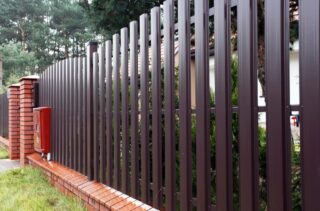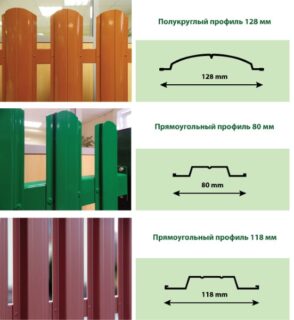A picket fence made of corrugated board is a budgetary and easy-to-install material for arranging a fence. For the construction of the fence, it is necessary to use material with rolled edges. For such tasks, it is advisable to purchase a ready-made euro shtaketnik. Self-production of it from a profiled sheet is permissible, provided that the products are processed on a rolling machine.
What is a professional sheet picket fence

A picket fence made of corrugated board consists of narrow (8-15 cm) strips mounted on wider crossbars. The edges of the structural elements are processed to eliminate the risk of injury during installation and operation. They are rolled up, and additional stiffeners are made on the bar itself, so that it is stronger and more stable.
If you cut the profiled sheet longitudinally without any further processing, the picket fence will have a number of disadvantages:
- due to their design (free edges and only 2 longitudinal folds), they do not have sufficient strength;
- they have sharp edges that make the products traumatic if a sheet of typical thickness (about 0.5 mm) was used;
- the appearance of such products does not have the presentability of a euro shtaketnik;
- cuts are often uneven: products without chipping and deformation are obtained with a successful combination of the skills of the master and a high-quality cutting mechanism.
A picket fence made of corrugated board for a fence can be used for budget fencing (for example, the territory of a summer cottage or a boundary plot of a large area), if contact of children or animals with products is not expected. In any case, it is better to prefer the option with rolled sides.
Planks can be mounted in one row or staggered. The second option involves the placement of elements both in front and behind the horizontal bars. In this case, the elements of both rows must at least partially overlap. This option requires about 1.6 times more planks than installation in one row, but the fence will turn out to be practically inaccessible to outsiders.
Products with non-rolled edges cannot be used for a checkerboard structure, otherwise there is a high risk of injury.
Types of picket fence from profiled sheet
The thickness of the sheet metal used for the products varies in the range of 0.4-1.5 mm. Thin options (0.4-0.5 mm) are most common. If we talk about the independent manufacture of a picket fence, it is these products that are the most traumatic. The width of the strips on sale is 8-13 cm. Their colors can be very different, it will not be difficult to choose a colored picket fence that suits the design solution of the site and the building.
Products differ in the shape of the profile. It can be rounded, look like a letter P or M. The last option is the most durable due to the increased number of ribs. However, there are varieties of U-shaped and semicircular profiles that can compete with it. They are grooved in the high part. The greater the number of stiffening ribs a product has, the higher its resistance to wind, mechanical and other loads.
Before buying, it is advisable to inspect the selected picket lot. Sometimes the manufacturer indicates that all the strips in it are of the same thickness, but in fact it turns out that some of them bend easily with fingers, while others do not lend themselves to such an effect. It is important that the purchased products have rolled sides and a high-quality protective coating. The processing of the sides protects against injury, makes the planks stiffer and more stable.
How to do it yourself

The corrugated board used must have a high wave (minimum 1.8 cm). It is better to choose asymmetrical products - with different wavelengths at the top and bottom. If you cut them along a narrow groove, you get strips that are close in size to an industrial picket fence. From brands C20 and MP20 are suitable. In no case should you take thin products of the C8 type - they are not strong enough even in sheet form.
For work, you will also need a workbench and a clamping bar to secure the corrugated board so that the products turn out to be even. A table with two clamps can serve as a workbench. If the floor is made of concrete, a soft cloth should be placed over it to ensure that the protective coating of the parts to be separated is not damaged by impact. It is impossible to cut the profiled sheet into picket fences with a grinder - the products will turn out to be uneven, with jagged edges. In addition, the protective coating will be broken.
It is better to purchase a nibbler that gives an even edge without chipping or other irregularities. The tool is safe to use, but it must be operated by weight, which requires some experience. You can also buy or design your own roller knife.
Putting the profiled sheet on the workbench and fixing it, draw a marking line along a ruler in the middle of a narrow wave. A bar is cut along it, smoothly moving the tool at the same speed. The procedure is repeated until the sheet is divided into pickets. The edges of the elements are seamed on a special machine.









